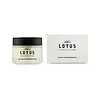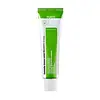What's inside
What's inside
 Key Ingredients
Key Ingredients

 Benefits
Benefits

 Concerns
Concerns

 Ingredients Side-by-side
Ingredients Side-by-side

Water
Skin ConditioningNelumbo Nucifera Leaf Extract
Skin ConditioningGlycerin
HumectantDipropylene Glycol
HumectantCetyl Ethylhexanoate
EmollientCaprylic/Capric Triglyceride
MaskingGlyceryl Stearate
EmollientCetearyl Alcohol
EmollientPentaerythrityl Tetraethylhexanoate
Emollient1,2-Hexanediol
Skin ConditioningBetaine
HumectantDimethicone
EmollientQuercus Acuta Branch/Leaf Extract
Skin ConditioningCyclopentasiloxane
EmollientBeeswax
Emulsion StabilisingSorbitan Stearate
EmulsifyingPEG-100 Stearate
Butylene Glycol
HumectantPolyacrylamide
Palmitic Acid
EmollientEthylhexylglycerin
Skin ConditioningCaprylyl Glycol
EmollientPolysilicone-11
Stearic Acid
CleansingC13-14 Isoparaffin
EmollientCarbomer
Emulsion StabilisingTromethamine
BufferingNylon-12
Silica
AbrasiveHippophae Rhamnoides Oil
EmollientAdenosine
Skin ConditioningLavandula Angustifolia Oil
MaskingCitrus Limon Peel Oil
MaskingLaureth-7
EmulsifyingDisodium EDTA
Ammonium Polyacryloyldimethyl Taurate
Emulsion StabilisingIsohexadecane
EmollientPolysorbate 40
EmulsifyingPEG-10 Dimethicone
Skin ConditioningCitrus Aurantifolia Oil
CleansingEucalyptus Globulus Leaf Oil
PerfumingRosmarinus Officinalis Leaf Oil
MaskingLauric Acid
CleansingMyristic Acid
CleansingCaramel
Cosmetic ColorantJuniperus Mexicana Oil
MaskingChamomilla Recutita Flower Oil
MaskingDextrin
AbsorbentPelargonium Graveolens Flower Oil
MaskingWater, Nelumbo Nucifera Leaf Extract, Glycerin, Dipropylene Glycol, Cetyl Ethylhexanoate, Caprylic/Capric Triglyceride, Glyceryl Stearate, Cetearyl Alcohol, Pentaerythrityl Tetraethylhexanoate, 1,2-Hexanediol, Betaine, Dimethicone, Quercus Acuta Branch/Leaf Extract, Cyclopentasiloxane, Beeswax, Sorbitan Stearate, PEG-100 Stearate, Butylene Glycol, Polyacrylamide, Palmitic Acid, Ethylhexylglycerin, Caprylyl Glycol, Polysilicone-11, Stearic Acid, C13-14 Isoparaffin, Carbomer, Tromethamine, Nylon-12, Silica, Hippophae Rhamnoides Oil, Adenosine, Lavandula Angustifolia Oil, Citrus Limon Peel Oil, Laureth-7, Disodium EDTA, Ammonium Polyacryloyldimethyl Taurate, Isohexadecane, Polysorbate 40, PEG-10 Dimethicone, Citrus Aurantifolia Oil, Eucalyptus Globulus Leaf Oil, Rosmarinus Officinalis Leaf Oil, Lauric Acid, Myristic Acid, Caramel, Juniperus Mexicana Oil, Chamomilla Recutita Flower Oil, Dextrin, Pelargonium Graveolens Flower Oil
Centella Asiatica Extract
CleansingWater
Skin ConditioningCaprylic/Capric Triglyceride
MaskingGlycerin
HumectantSqualane
EmollientCetearyl Alcohol
EmollientButylene Glycol
Humectant1,2-Hexanediol
Skin ConditioningNiacinamide
SmoothingMacadamia Ternifolia Seed Oil
EmollientButyrospermum Parkii Butter Extract
Skin ConditioningHydrogenated Lecithin
EmulsifyingTribehenin
EmollientStearic Acid
CleansingBehenic Acid
CleansingArgania Spinosa Kernel Oil
EmollientTromethamine
BufferingSpent Grain Wax
Skin ConditioningCarbomer
Emulsion StabilisingCaprylyl Glycol
EmollientTremella Fuciformis Extract
HumectantSodium Hyaluronate
HumectantPerilla Ocymoides Seed Extract
AntioxidantHamamelis Virginiana Extract
AntiseborrhoeicBetaine
HumectantBeta-Glucan
Skin ConditioningCitrus Aurantium Bergamia Fruit Oil
MaskingXanthan Gum
EmulsifyingSodium Carbomer
Emulsion StabilisingHydroxyethylcellulose
Emulsion StabilisingAdenosine
Skin ConditioningLavandula Angustifolia Oil
MaskingAsiaticoside
AntioxidantAsiatic Acid
Skin ConditioningPhytosphingosine
Skin ConditioningCeramide NP
Skin ConditioningMadecassic Acid
Skin ConditioningTocopherol
AntioxidantCentella Asiatica Extract, Water, Caprylic/Capric Triglyceride, Glycerin, Squalane, Cetearyl Alcohol, Butylene Glycol, 1,2-Hexanediol, Niacinamide, Macadamia Ternifolia Seed Oil, Butyrospermum Parkii Butter Extract, Hydrogenated Lecithin, Tribehenin, Stearic Acid, Behenic Acid, Argania Spinosa Kernel Oil, Tromethamine, Spent Grain Wax, Carbomer, Caprylyl Glycol, Tremella Fuciformis Extract, Sodium Hyaluronate, Perilla Ocymoides Seed Extract, Hamamelis Virginiana Extract, Betaine, Beta-Glucan, Citrus Aurantium Bergamia Fruit Oil, Xanthan Gum, Sodium Carbomer, Hydroxyethylcellulose, Adenosine, Lavandula Angustifolia Oil, Asiaticoside, Asiatic Acid, Phytosphingosine, Ceramide NP, Madecassic Acid, Tocopherol
 Reviews
Reviews

Ingredients Explained
These ingredients are found in both products.
Ingredients higher up in an ingredient list are typically present in a larger amount.
1,2-Hexanediol is a synthetic liquid and another multi-functional powerhouse.
It is a:
- Humectant, drawing moisture into the skin
- Emollient, helping to soften skin
- Solvent, dispersing and stabilizing formulas
- Preservative booster, enhancing the antimicrobial activity of other preservatives
Adenosine is in every living organism. It is one of four components in nucleic acids that helps store our DNA.
Adenosine has many benefits when used. These benefits include hydrating the skin, smoothing skin, and reducing wrinkles. Once applied, adenosine increases collagen production. It also helps with improving firmness and tissue repair.
Studies have found adenosine may also help with wound healing.
In skincare products, Adenosine is usually derived from yeast.
Learn more about AdenosineBetaine is a common humectant (a substance that promotes retention of moisture). It's known to be gentle on the skin and can help balance hydration.
This ingredient is best for improving hydration and soothing irritated skin. Studies also show it helps even out skin tone.
Fun fact: Betaine is naturally created in the skin and body. The kind found within cosmetic products can be either plant-derived or synthetic.
Another name for betaine is trimethylglycine.
Learn more about BetaineButylene Glycol (or BG) is used within cosmetic products for a few different reasons:
Overall, Butylene Glycol is a safe and well-rounded ingredient that works well with other ingredients.
Though this ingredient works well with most skin types, some people with sensitive skin may experience a reaction such as allergic rashes, closed comedones, or itchiness.
Learn more about Butylene GlycolThis ingredient is an emollient, solvent, and texture enhancer. It is considered a skin-softener by helping the skin prevent moisture loss.
It helps thicken a product's formula and makes it easier to spread by dissolving clumping compounds.
Caprylic Triglyceride is made by combining glycerin with coconut oil, forming a clear liquid.
While there is an assumption Caprylic Triglyceride can clog pores due to it being derived from coconut oil, there is no research supporting this.
Learn more about Caprylic/Capric TriglycerideCaprylyl Glycol is a humectant and emollient, meaning it attracts and preserves moisture.
It is a common ingredient in many products, especially those designed to hydrate skin. The primary benefits are retaining moisture, skin softening, and promoting a healthy skin barrier.
Though Caprylyl Glycol is an alcohol derived from fatty acids, it is not the kind that can dry out skin.
This ingredient is also used as a preservative to extend the life of products. It has slight antimicrobial properties.
Learn more about Caprylyl GlycolCarbomer is a polymer of acrylic acid. Its main role is to create a gel consistency.
A high amount of carbomer can cause pilling or balling up of products. Don't worry, most products contain 1% or less of carbomer.
Cetearyl alcohol is a mixture of two fatty alcohols: cetyl alcohol and stearyl alcohol. It is mainly used as an emulsifier. Emulsifiers help prevent the separation of oils and products. Due to its composition, it can also be used to thicken a product or help create foam.
Cetearyl alcohol is an emollient. Emollients help soothe and hydrate the skin by trapping moisture.
Studies show Cetearyl alcohol is non-toxic and non-irritating. The FDA allows products labeled "alcohol-free" to have fatty alcohols.
This ingredient is usually derived from plant oils such as palm, vegetable, or coconut oils. There is debate on whether this ingredient will cause acne.
Due to the fatty acid base, this ingredient may not be Malassezia folliculitis safe.
Learn more about Cetearyl AlcoholGlycerin is already naturally found in your skin. It helps moisturize and protect your skin.
A study from 2016 found glycerin to be more effective as a humectant than AHAs and hyaluronic acid.
As a humectant, it helps the skin stay hydrated by pulling moisture to your skin. The low molecular weight of glycerin allows it to pull moisture into the deeper layers of your skin.
Hydrated skin improves your skin barrier; Your skin barrier helps protect against irritants and bacteria.
Glycerin has also been found to have antimicrobial and antiviral properties. Due to these properties, glycerin is often used in wound and burn treatments.
In cosmetics, glycerin is usually derived from plants such as soybean or palm. However, it can also be sourced from animals, such as tallow or animal fat.
This ingredient is organic, colorless, odorless, and non-toxic.
Glycerin is the name for this ingredient in American English. British English uses Glycerol/Glycerine.
Learn more about GlycerinLavandula Angustifolia Oil is more commonly known as lavender essential oil. It is considered a fragrancing ingredient.
Lavender imparts a famous scent. While the smell is lovely, this ingredient and may sensitize skin in topical products. This is because about 85% of the oil is made up of linalool and linalyl acetate.
When exposed to air, these two compounds become strong allergens. This ingredient exhibits cytotoxicity at low concentrations; amounts of 0.25% have been shown to damage skin cells.
A study from Japan found this ingredient caused lavender sensitivity after widespread exposure.
Lavender essential oil has some antimicrobial, antibacterial, and anti-inflammatory properties. However, the cons of this ingredient may outweight the pros.
More research is needed to confirm lavender essential oil's effects when used in aromatherapy.
Lavandula Angustifolia is known as the English Lavender and famous for creating purple fields in Provence, France.
Learn more about Lavandula Angustifolia OilStearic Acid is a fatty acid. It is an emollient, emulsifier, and texture enhancer.
As an emollient, stearic acid helps soften skin. It aids the skin's protective barrier by preventing water loss. It also provides a gentle cleansing effect without stripping away natural oils.
Stearic acid may also be used to enhance the texture of products. It can add volume and stabilize ingredients such as water and oil. This can help water and oil ingredients from separating.
Sources of stearic acid include animal or vegetable fats/oils such as coconut or shea. It can be naturally found in butter, cocoa butter, shea butter, vegetable fats, and animal tallow.
This ingredient may not be Malassezia folliculitis, or fungal-acne safe.
Learn more about Stearic AcidTromethamine helps balance the pH and improve the texture of a product. It is synthetically created.
As an emulsifier, Tromethamine prevents oil and water ingredients from separating. This helps stabilize the product and elongate a product's shelf life. Tromethamine also makes a product thicker.
Tromethamine helps balance the pH level of a product. Normal pH level of skin is slightly acidic (~4.75-5.5). The acidity of our skin is maintained by our glands and skin biome. Being slightly acidic allows our skin to create an "acid mantle". This acid mantle is a thin barrier that protects our skin from bacteria and contaminants.
Oral Tromethanmine is an anti-inflammatory drug but plays the role of masking, adding fragrance, and/or balancing pH in skincare.
1,3-Propanediol, 2-amino-2-(hydroxymethyl)-
Learn more about TromethamineWater. It's the most common cosmetic ingredient of all. You'll usually see it at the top of ingredient lists, meaning that it makes up the largest part of the product.
So why is it so popular? Water most often acts as a solvent - this means that it helps dissolve other ingredients into the formulation.
You'll also recognize water as that liquid we all need to stay alive. If you see this, drink a glass of water. Stay hydrated!
Learn more about Water